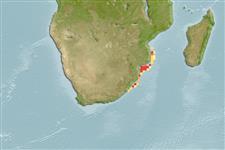Elasmobranchii (sharks and rays) >
Rajiformes (Skates and rays) >
Rajidae (Skates)
Etymology: Dipturus: Greek, di = two + Greek, pteryx = fin (Ref. 45335).
Environment: milieu / climate zone / depth range / distribution range
Ecology
Marine; bathydemersal; depth range 253 - 761 m (Ref. 11228). Deep-water; 20°S - 32°S, 30°E - 38°E (Ref. 114953)
Western Indian Ocean: southern Mozambique to Plettenberg Bay, South Africa.
Size / Weight / Age
Maturity: Lm ? range ? - ? cm
Max length : 101 cm TL male/unsexed; (Ref. 114953)
Short description
Identification keys | Morphology | Morphometrics
An all-dark longnose skate with a greatly elongated, broadly triangular snout, and a stout tail - shorter than body and with mid-section swollen and triangular-shaped; disc with angular corners and smooth underside; small thorn at nape (Ref. 5578). Uniform dark grey above and below with black mucous pores on the underside (Ref. 2708, 5578).
Found on upper and mid-continental slope (Ref. 114953). Oviparous (Ref. 50449). Eggs have horn-like projections on the shell (Ref. 205). Males reaches maturity at ca. 83-98 cm TL; smallest known specimen at 24 cm TL; hatching size possibly at ca. 24 cm TL (Ref. 114953).
Life cycle and mating behavior
Maturities | Reproduction | Spawnings | Egg(s) | Fecundities | Larvae
Oviparous, paired eggs are laid. Embryos feed solely on yolk (Ref. 50449). Eggs have horn-like projections on the shell (Ref. 205).
McEachran, J.D. and K.A. Dunn, 1998. Phylogenetic analysis of skates, a morphologically conservative clade of elasmobranchs (Chondrichthyes: Rajidae). Copeia 1998(2):271-290. (Ref. 27314)
IUCN Red List Status (Ref. 130435)
Threat to humans
Harmless
Human uses
Fisheries: of no interest
Tools
Special reports
Download XML
Internet sources
Estimates based on models
Preferred temperature (Ref.
123201): 9.7 - 12.9, mean 11.5 °C (based on 27 cells).
Phylogenetic diversity index (Ref.
82804): PD
50 = 0.5000 [Uniqueness, from 0.5 = low to 2.0 = high].
Bayesian length-weight: a=0.00282 (0.00133 - 0.00596), b=3.25 (3.08 - 3.42), in cm total length, based on LWR estimates for this Genus-body shape (Ref.
93245).
Trophic level (Ref.
69278): 3.9 ±0.6 se; based on size and trophs of closest relatives
Resilience (Ref.
120179): Low, minimum population doubling time 4.5 - 14 years (Fec assumed to be <100).
Fishing Vulnerability (Ref.
59153): High vulnerability (61 of 100).
